- Types of Sailboats
- Parts of a Sailboat
- Cruising Boats
- Small Sailboats
- Design Basics
- Sailboats under 30'
- Sailboats 30'-35
- Sailboats 35'-40'
- Sailboats 40'-45'
- Sailboats 45'-50'
- Sailboats 50'-55'
- Sailboats over 55'
- Masts & Spars
- Knots, Bends & Hitches
- The 12v Energy Equation
- Electronics & Instrumentation
- Build Your Own Boat
- Buying a Used Boat
- Choosing Accessories
- Living on a Boat
- Cruising Offshore
- Sailing in the Caribbean
- Anchoring Skills
- Sailing Authors & Their Writings
- Mary's Journal
- Nautical Terms
- Cruising Sailboats for Sale
- List your Boat for Sale Here!
- Used Sailing Equipment for Sale
- Sell Your Unwanted Gear
- Sailing eBooks: Download them here!
- Your Sailboats
- Your Sailing Stories
- Your Fishing Stories
- Advertising
- What's New?
- Chartering a Sailboat
- Cruising Yachts 30' to 35'

The Hunter 33 Sailboat Specs & Key Performance Indicators
The Hunter 33 is a popular American sailboat that was designed by John Cherubini and first built in 1977 by Hunter Marine. It has a masthead sloop rig, a fixed fin keel, an inboard motor, and is known for its spacious interior, easy handling and good performance.
The boat has undergone several revisions and updates over the years, and has been compared to other sailboats in its class such as the Catalina 34, the Beneteau Oceanis 331, and the Tartan 3400.
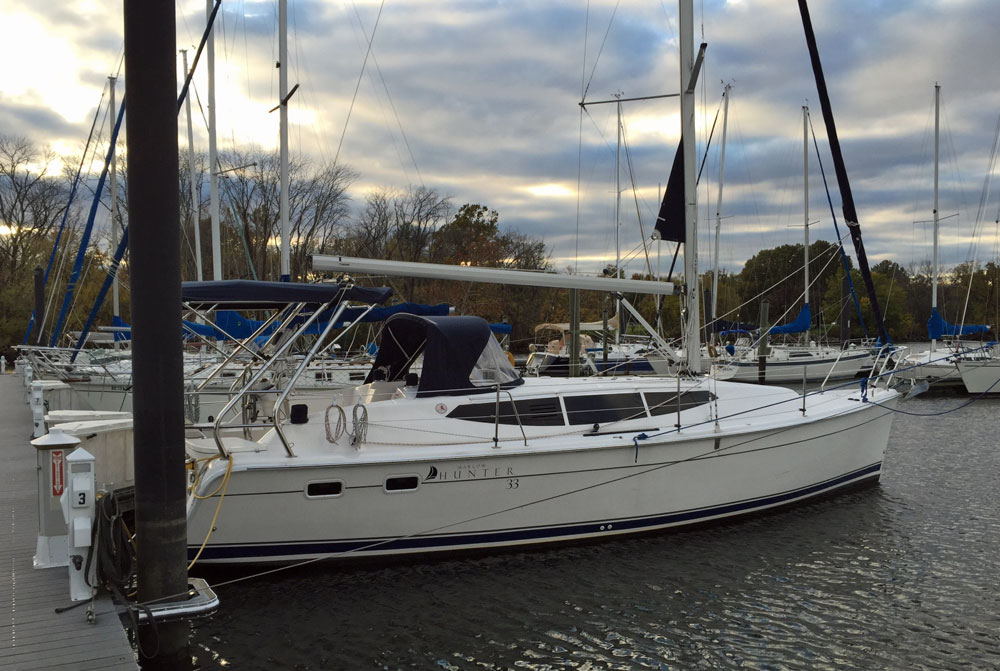
Published Specification for the Hunter 33
Underwater Profile: Fin with bulb keel and Spade Rudder
Hull Material : GRP (Fibreglass)
Length Overall : 33'6" (10.21m)
Waterline Length : 29'5" (8.97m)
Beam : 11'8" (3.51m)
Draft : 5'6" (1.7m) *
Rig Type : B&R
Displacement : 12,400lb (5,625kg)
Designer : Hunter Marine
Builder : Hunter Marine (USA)
Year First Built : 2012
* Shoal Draft version: 4'6" (1.4m)
Published Design Ratios for the Hunter 33
1. Sail Area/Displacement Ratio: 18.7
- Less than 16 would be considered under-powered;
- 16 to 20 would indicate reasonably good performance;
- Over 20 suggests relatively high performance.
2. Ballast/Displacement Ratio: 27.9
- Under 40: less stiff, less powerful
- Over 40: stiffer, more powerful
3. Displacement/Length Ratio: 217
- Under 100: Ultralight
- 100 to 200: Light
- 200 to 275: Moderate
- 275 to 350: Heavy
- Over 350: Ultraheavy
4. Comfort Ratio: 24.2
- Under 20 indicates a lightweight racing boat
- 20 to 30 indicates a coastal cruiser
- 30 to 40 indicates a moderate offshore cruising boat
- 40 to 50 indicates a heavy offshore boat
- Over 50 indicates an extremely heavy offshore boat
5. Capsize Screening Formula: 2.0
- Under 2.0 (the lower the better): Better suited for ocean passages
- Over 2.0: Less suited for ocean passages
read more about these all-revealing numbers...
A Few FAQs...
Is the Hunter 33 still in production and, if not, when did production end and how many of these sailboats were built?
- The original Hunter 33 was produced from 1977 to 1984 by Hunter Marine in Alachua, Florida. A total of 1,124 hulls were built during this period.
- The second generation Hunter 33 was introduced in 2005 as an updated version of the previous model with some design changes and improvements. It was produced until 2011 by Hunter Marine in Alachua, Florida. A total of 623 hulls were built during this period.
- The third generation Hunter 33 was launched in 2012 as a completely new design with a different hull shape, deck plan, rig configuration, interior layout, and features. It was produced until 2016 by Marlow-Hunter (formerly Hunter Marine) in Alachua, Florida.
- The current generation Hunter E33 (also known as Marlow-Hunter E33) was introduced in 2017 as an electric hybrid version of the previous model with an Elco electric motor instead of a diesel engine. It is still in production by Marlow-Hunter in Alachua, Florida.
What, if any, alternative versions of the Hunter 33 were built and what are the differences between them?
The original Hunter 33:
- was offered with two keel options - a standard fin keel with a draft of 5.25 feet, and a shoal draft keel with a draft of 4.0 feet.
- had a masthead sloop rig with a single spreader and no backstay.
- had a traditional transom with a small swim platform and ladder.
- had an interior layout that featured a V-berth forward, a head to port, a hanging locker to starboard, a U-shaped dinette to port, a settee to starboard, an L-shaped galley to port, and a quarter berth to starboard.
The second-generation Hunter 33:
- was also offered with two keel options - a standard fin keel with a draft of 4.5 feet, and a shoal draft wing keel with a draft of 4.0 feet.
- had a fractional sloop rig with a single spreader and no backstay, but with swept-back spreaders and shrouds that provided more support for the mast.
- had a reverse transom with a larger swim platform and ladder.
- had an interior layout that featured a V-berth forward, a head to starboard, a hanging locker to port, a U-shaped dinette to starboard, a settee to port, an L-shaped galley to starboard, and an aft cabin to port.
The third-generation Hunter 33:
- was only offered with one keel option - a fin keel with a draft of 4.5 feet.
- had a fractional sloop rig with a double spreader and no backstay, but with swept-back spreaders and shrouds that provided even more support for the mast.
- had a raised reverse transom with an even larger swim platform and ladder, as well as an arch that supported the mainsheet traveler and the optional bimini and dodger.
- had an interior layout that featured an island berth forward, a head to port, a hanging locker to starboard, an L-shaped dinette to port, two seats and a table to starboard, an L-shaped galley to port, and an aft cabin to starboard.
The current generation Hunter E33:
- has the same transom as the third-generation Hunter 33.
- has the same rig as the third-generation Hunter 33.
- has the same interior layout as the third-generation Hunter 33.
- is also only offered with one keel option - a fin keel with a draft of 4.5 feet.
How many people can sleep on board a Hunter 33?
- The original Hunter 33 could sleep up to five people: two in the V-berth, two in the dinette (converted into a double berth), and one in the quarter berth.
- The second-generation Hunter 33 could sleep up to six people: two in the V-berth, two in the dinette (converted into a double berth), two in the aft cabin (in either one double berth or two single berths).
- The third-generation Hunter 33 could sleep up to six people: two in the island berth forward, two in the dinette (converted into a double berth), two in the aft cabin (in one double berth).
- The current generation Hunter E33 can sleep up to six people: two in the island berth forward, two in the dinette (converted into a double berth), two in the aft cabin (in one double berth).
What is the history of the builders of the Hunter 33 and is the company still in business?
The builders of the Hunter 33 are Hunter Marine, which was founded in 1973 by Warren Luhrs, a successful sailboat racer who wanted to create affordable and high-quality sailboats for the mass market. The company started with a 25-foot boat called the Hunter 25, which was an instant success and sold over 2,000 units in its first year. The company then expanded its product line to include various models ranging from 15 to 50 feet in length.
The Hunter 33 was one of the most popular models, selling over 1,700 units in its first generation alone. The company also pioneered some innovative features such as the B&R rig (a fractional sloop rig with no backstay), the arch (a stainless steel structure that supports the mainsheet traveler and other accessories), and the electric hybrid propulsion system.
The company is still in business today, but under a different name and ownership. In 2012, Hunter Marine was acquired by David Marlow, a veteran boat builder who also owns Marlow Yachts, a luxury powerboat manufacturer.
The new company was renamed Marlow-Hunter and continued to produce sailboats under the Hunter brand name, as well as introducing new models under the Marlow brand name. The current product line includes sailboats from 15 to 50 feet in length, as well as powerboats from 37 to 97 feet in length.
What is the average cost of a secondhand Hunter 33?
The average cost of a secondhand Hunter 33 depends on the condition, age, equipment, and location of the boat. According to some online sources, the average cost of a secondhand Hunter 33 ranges from $20,000 to $150,000, depending on the generation and model year of the boat. For example, a 1980 original Hunter 33 in fair condition may cost around $20,000, while a 2016 third-generation Hunter 33 in excellent condition may cost around $150,000.
How does the Hunter 33 compare to other sailboats in its class?
The Hunter 33 is comparable to other sailboats in its class, such as the Catalina 34, the Beneteau Oceanis 331, and the Tartan 3400. These boats are all similar in size, design, and performance, but have some differences in features, quality, and price. Some of the comparisons are:
- The Catalina 34 is slightly larger than the Hunter 33, with a length of 34.5 feet and a beam of 11.75 feet. It has a masthead sloop rig with a single spreader and a backstay, and a fin or wing keel with a draft of either 5.67 or 3.83 feet. It has an interior layout that features a V-berth forward, a head to port, a hanging locker to starboard, a U-shaped dinette to starboard, a settee to port, an L-shaped galley to port, and an aft cabin to starboard. It has a traditional transom with a small swim platform and ladder. It was produced from 1986 to 1999 by Catalina Yachts in Woodland Hills, California. A total of 1,438 hulls were built during this period. The Catalina 34 is known for its spacious interior, solid construction, and good performance. It is also more affordable than the Hunter 33, with an average cost of around $40,000 for a secondhand boat.
- The Beneteau Oceanis 331 is slightly smaller than the Hunter 33, with a length of 33.1 feet and a beam of 11.3 feet. It has a fractional sloop rig with a single spreader and no backstay, but with swept-back spreaders and shrouds that provide more support for the mast. It has a fin or bulb keel with a draft of either 5.58 or 4.25 feet. It has an interior layout that features an island berth forward or two single berths forward (depending on the version), a head to starboard or port (depending on the version), a hanging locker to port or starboard (depending on the version), an L-shaped dinette to starboard or port (depending on the version), two seats and a table to port or starboard (depending on the version), an L-shaped galley to starboard or port (depending on the version), and an aft cabin to port or starboard (depending on the version). It has a reverse transom with a large swim platform and ladder. It was produced from 1999 to 2006 by Beneteau in France and South Carolina. The Beneteau Oceanis 331 is known for its modern design, versatile layout, and good performance. It is also more expensive than the Hunter 33, with an average cost of around $60,000 for a secondhand boat.
- The Tartan 3400 is slightly larger than the Hunter 33, with a length of 34.4 feet and a beam of 11.25 feet. It has a fractional sloop rig with a double spreader and a backstay, and a fin or beavertail keel with a draft of either 6.5 or 4.75 feet. It has an interior layout that features a V-berth forward, a head to port, a hanging locker to starboard, an L-shaped dinette to port, two seats and a table to starboard, an L-shaped galley to port, and an aft cabin to starboard. It has a traditional transom with a small swim platform and ladder. It was produced from 2005 to present by Tartan Yachts in Fairport Harbor, Ohio. The Tartan 3400 is known for its classic style, high quality, and excellent performance. It is also more premium than the Hunter 33, with an average cost of around $120,000 for a secondhand boat.
The above answers were drafted by sailboat-cruising.com using GPT-4 (OpenAI’s large-scale language-generation model) as a research assistant to develop source material; to the best of our knowledge, we believe them to be accurate.
Other sailboats in the Hunter range include:
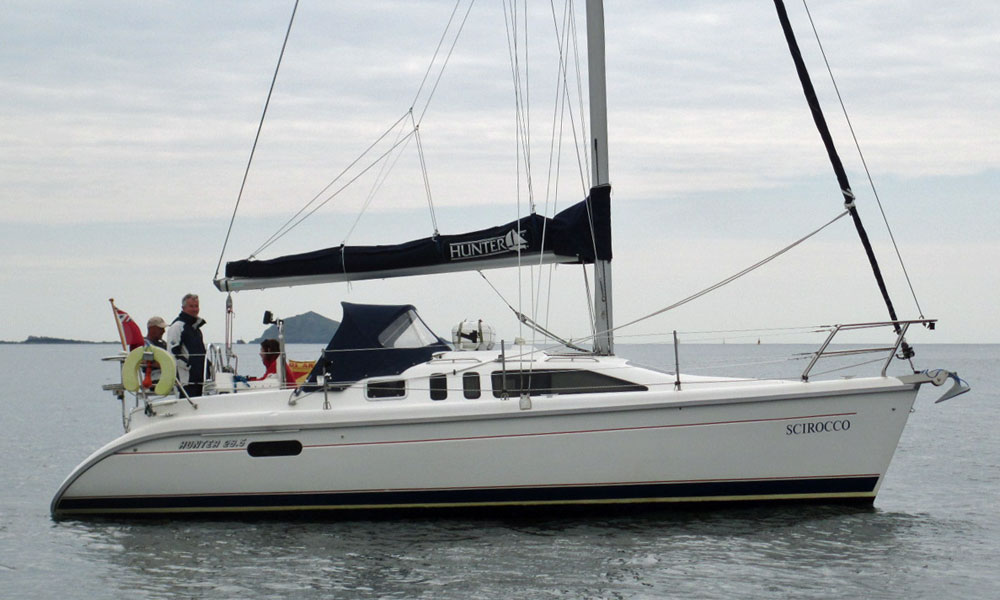
Recent Articles
The CSY 44 Mid-Cockpit Sailboat
Sep 15, 24 08:18 AM
Hallberg-Rassy 41 Specs & Key Performance Indicators
Sep 14, 24 03:41 AM
Amel Kirk 36 Sailboat Specs & Key Performance Indicators
Sep 07, 24 03:38 PM
Here's where to:
- Find Used Sailboats for Sale...
- Find Used Sailing Gear for Sale...
- List your Sailboat for Sale...
- List your Used Sailing Gear...
Our eBooks...

A few of our Most Popular Pages...

Copyright © 2024 Dick McClary Sailboat-Cruising.com
Hunter 33 - 2004 Shoal draft
Sailboat specifications.
- Last update: 10th April 2020
Hunter 33 - 2004's main features
Hunter 33 - 2004's main dimensions, hunter 33 - 2004's rig and sails, hunter 33 - 2004's performances, hunter 33 - 2004's auxiliary engine, hunter 33 - 2004's accommodations and layout.

Similar sailboats that may interest you:
- BOAT OF THE YEAR
- Newsletters
- Sailboat Reviews
- Boating Safety
- Sails and Rigging
- Maintenance
- Sailing Totem
- Sailor & Galley
- Living Aboard
- Destinations
- Gear & Electronics
- Charter Resources
- Ultimate Boating Giveaway

- By Alvah Simon
- Updated: November 12, 2012
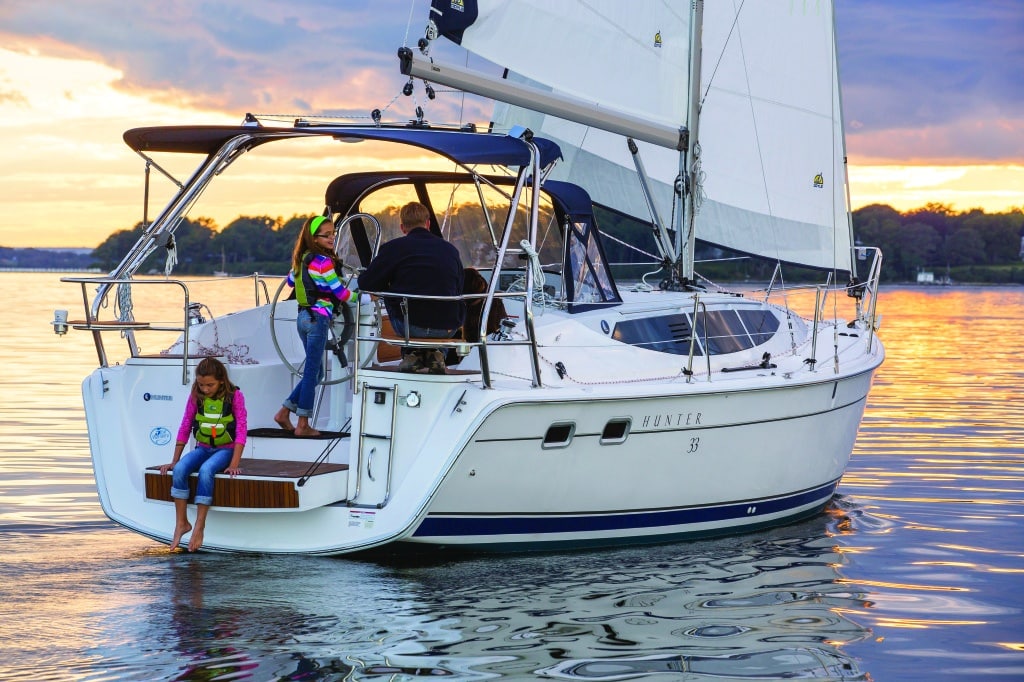
The boatbuilders at Marlow-Hunter , formerly known as Hunter Marine, may have been too successful, if that’s possible, with their prodigious production run of more than 600 Hunter 33 s. They found that the boat’s secondhand market was so vibrant that, in essence, they were competing against themselves for new-boat sales. They decided that by offering a new family cruiser of the same size but with significant innovations and upgrades, they might lure customers back into the new-boat market, and if they made the price very attractive, they might also entice trailer-sailors to make the leap up into a manageable keelboat.
The innovations and improvements found in the new and completely revamped Hunter 33 aren’t mere window dressing; they’re genuine leaps forward in speed, handling, comfort, and value. Always lurking is the risk of trying to squeeze too much into a small hull, such as larger cockpits, more spacious decks, increased interior volume, and a plethora of modern gadgetry. But Glen Henderson and the Hunter Design Group have found a superb balance in this package of upgrades.
The new hull still maintains Henderson’s signature hollow bow but now sports a trendy hard chine. By placing it beneath the waterline, Henderson sacrificed the cosmetic flourish of an elevated chine but found the sweet spot in terms of form stability and lateral resistance while under way.
Small but ultimately significant adjustments to the deck design add up to notable ergonomic efficiency. The cockpit pedestal has been moved back a few inches to create a larger cockpit area. A clever drop-down/walk-through transom adds to the usable space, and because this is a relatively high-sided vessel, it will be the preferred boarding point. The offset boarding ladder will come in handy for swimmers. The Lewmar wheel, when folded in, opens the access forward. But even in its full open position, it offers 10 inches of clearance between the wheel and the cockpit seats, giving the helmsman quick access to the sailing controls forward on the cabin top.
Two seats sculpted into the impregnable aft pulpit add to the already spacious outdoor social area. The steering pedestal is stout and holds an array of engine and navigational instruments, and it acts as the base for a sizable folding cockpit table.
It wouldn’t be a Hunter without the forward sloping arch with overhead, dual-ended mainsail sheeting. The headsail sheet winches are adequately sized and placed handy to the helm. Sheet wells built into the companionway bulkheads tame the abundance of sheets, halyards, and furling lines led aft to the cabin top.
There are ample stowage lockers, and the twin-bottle LPG locker is particularly well designed. I don’t like the three-washboard arrangement on a tapered companionway hatch, but this was the only fault I found in an otherwise excellent cockpit plan.
The deck has been redesigned with larger deadlights that allow more light below. Also, the lower shrouds have been moved inboard, creating an unencumbered flow forward. The new seahood covers the many lines leading aft, leaving a cleaner and, therefore, safer deck. The foredeck workspace is well thought out, with a small but adequate rode locker, a single roller, a recessed Lewmar windlass, and a snubbing cleat. The twin lifelines are coated but stand a minimal 23 inches high. I’d like to see this figure raised across the industry.
Though not touted as a performance cruiser, I found the 33 to be quick and responsive. Even with the in-mast furling option (not the fastest of sail plans), in only 5 to 7 knots of breeze, we maintained an honest 5.5 knots to windward and just under 5 with the wind on the beam. The 33 tacked effortlessly and tracked well. All in all, this is a slippery yet well-behaved hull.
Under power—the boat we tested had a 29-horsepower Yanmar diesel with saildrive—the vessel showed a good turn of speed, touching 6.5 knots at a cruising rpm and 7.5 when flat-out. (A 21-horsepower engine is also available.) It backed with precision and, due to the highly efficient balanced spade rudder, turned nearly in its own length. With the 33’s small size and snappy responsiveness, the boat should prove quite manageable in tight quarters.
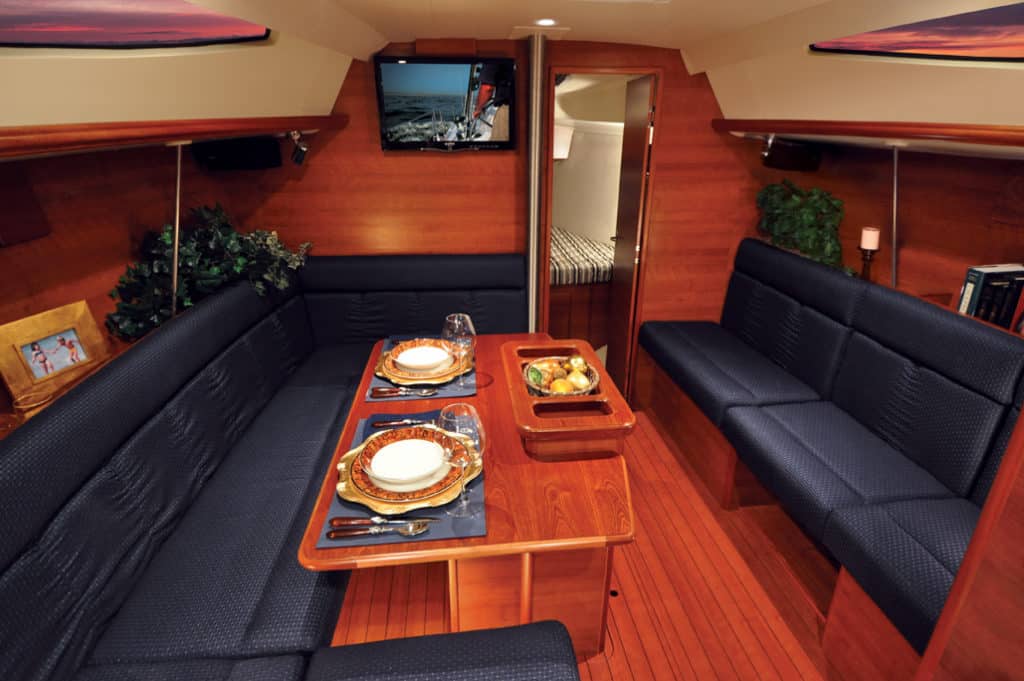
Where it really shines, however, is below. The interior is surprisingly spacious, bright, and well ventilated. Good handholds and the rounded teak companionway steps lead one safely below. A single full-size head and shower lie to starboard, across from a well-executed galley to port. The countertops are an attractive and practical white speckled Corian. A stainless-steel rail acts as both fiddle and handhold. The two-burner stove/oven is well fiddled but could use a little more angle when gimbaled. There’s a single but deep sink. The galley is large enough to work in conveniently but enclosed enough for safe use at sea.
The main saloon sports a very clever central table that’s built around a liquor/stowage cabinet. The table drops to create an additional berth. Across to starboard, a bench seat can be folded up to create a central cocktail table that doubles as the navigation station. Other amenities include a flat-screen TV and even an iPod docking station. Not mere gimmickry, this is a commitment to bringing the company’s styling, amenities, and electrical/mechanical systems up to the most modern of standards.
The owners cabin forward is bright, spacious, and offers good stowage spaces. The athwartship guest double lies in the stern to starboard.
The fit and finish are fine, and the overall cherry color and styling is pleasing to the eye. But more important, it must be noted again that this is only a 33-foot sailboat, and yet it contains two private cabins, a full-service galley, a spacious central saloon area, a full-size head and shower, and a navigation station—while still offering easy engine access and room to spare for generous stowage of gear.
The Hunter 33 shows no incongruities in its core concept. This is a contemporary-looking, modern-feeling coastal or near-offshore cruiser designed to take an entire family to sea in ease, style, and comfort. The good news is that it can do this at an amazingly attractive price. With that combination of looks, performance, and value, Marlow-Hunter may find itself faced again, perhaps in just a few years, with the same fortunate problem that its new 33 was designed to solve.
Two-time circumnavigator Alvah Simon is a Cruising World Boat of the Year judge for 2013.
View a full photo gallery for the Hunter 33 here . Check out more boat reviews here .
- More: 2011+ , 31 - 40 ft , Boat of the Year , Coastal Cruising , marlow-hunter , monohull , Sailboat Reviews , Sailboats
- More Sailboats

Pre-Owned: 1988 Hylas 47

Catalina Introduces the 6 Series

Sailboat Preview: Elan GT6 Explorer

For Sale: 1984 Camper & Nicholsons 58

Galápagos: A Paradise Worth the Paperwork

Around Alone

Grease the Wheels of Your Boat: A Guide to Proper Lubrication

A Bowsprit Reborn: A DIY Renovation Story
- Digital Edition
- Customer Service
- Privacy Policy
- Terms of Use
- Email Newsletters
- Cruising World
- Sailing World
- Salt Water Sportsman
- Sport Fishing
- Wakeboarding
- New Sailboats
- Sailboats 21-30ft
- Sailboats 31-35ft
- Sailboats 36-40ft
- Sailboats Over 40ft
- Sailboats Under 21feet
- used_sailboats
- Apps and Computer Programs
- Communications
- Fishfinders
- Handheld Electronics
- Plotters MFDS Rradar
- Wind, Speed & Depth Instruments
- Anchoring Mooring
- Running Rigging
- Sails Canvas
- Standing Rigging
- Diesel Engines
- Off Grid Energy
- Cleaning Waxing
- DIY Projects
- Repair, Tools & Materials
- Spare Parts
- Tools & Gadgets
- Cabin Comfort
- Ventilation
- Footwear Apparel
- Foul Weather Gear
- Mailport & PS Advisor
- Inside Practical Sailor Blog
- Activate My Web Access
- Reset Password
- Customer Service

- Free Newsletter

Blue Jacket 40 Used Boat Review

Catalina 270 vs. The Beneteau First 265 Used Boat Match-Up

Ericson 41 Used Boat Review

Mason 33 Used Boat Review

How to Create a Bullet-Proof VHF/SSB Backup

Tips From A First “Sail” on the ICW

Tillerpilot Tips and Safety Cautions

Best Crimpers and Strippers for Fixing Marine Electrical Connectors

Polyester vs. Nylon Rode

Getting the Most Out of Older Sails

How (Not) to Tie Your Boat to a Dock

Stopping Mainsheet Twist

Fuel Lift Pump: Easy DIY Diesel Fuel System Diagnostic and Repair

Ensuring Safe Shorepower

Sinking? Check Your Stuffing Box

What Do You Do With Old Fiberglass Boats?

Boat Repairs for the Technically Illiterate

Boat Maintenance for the Technically Illiterate

Whats the Best Way to Restore Clear Plastic Windows?

Stopping Holding-tank Odors

Giving Bugs the Big Goodbye

Galley Gadgets for the Cruising Sailor

The Rain Catcher’s Guide

Sailing Gear for Kids

What’s the Best Sunscreen?

UV Clothing: Is It Worth the Hype?

Preparing Yourself for Solo Sailing

R. Tucker Thompson Tall Ship Youth Voyage

On Watch: This 60-Year-Old Hinckley Pilot 35 is Also a Working…

On Watch: America’s Cup

On Watch: All Eyes on Europe Sail Racing

Dear Readers
- Sailboat Reviews
New Boat Review: Hunter 33
Redesigned family cruising boat sports new transom and deck plan..
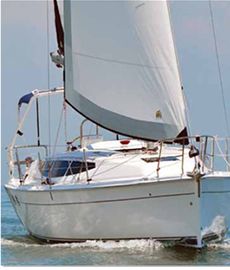
Photos courtesy of Hunter Marine
The new Hunter 33 had the odds stacked against it from the get-go.
The 33-foot family cruiser debuted in the fall of 2011, when the domestic sailboat market was stuck in a ditch, marketing budgets were slashed, and the U.S. boating industry was grasping at threads of good news. Four months later, Hunter Marine’s parent group Luhrs Marine filed for Chapter 11 bankruptcy protection.
Against all odds, however, the 33 is selling well. More than 60 have been ordered since the boat was introduced, and all but a few that have been built have been sold. It is one of Hunter’s best debuts since the 2008 downturn.
Looking ahead, the bankruptcy filing should be a boon for Hunter, as it will unshackle the sailboat side of the business from the struggling powerboat brands. Hunter, which converted to an employee-owned operation in 1996, expects to be out of the bankruptcy weeds by the end of July.

While new ownership appears in the offing for Hunter, co-founder Warren Luhrs will likely still have a stake. Luhrs—who’s 80-day sail from New York to San Francisco set a record in 1989—helped redefine Hunter in the 1990s. Under his leadership, design innovations by the late Swedish engineer Lars Bergstrom (the “B” in Hunter’s signature backstayless B&R rig) and faster hulls from designer Glen Henderson helped propel Hunter’s makeover through the last two decades.
“We have several very promising buyers interested, one in particular, but we can’t say anything right now,” said Greg Emerson, Hunter’s chief of public relations. The company has secured financing from Bank of America to help with the transition, allowing Hunter to continue full operations and provide warranty support without interruption.
Of the big three American boatbuilders (Catalina and Beneteau USA are the other two), Hunter reached the farthest outside the box as the traditional boat market sagged. The hybrid powerboat-sailboat Hunter Edge introduced in 2009 was a sharp departure from its usual fare. In 2010, it launched the Elco-powered electric hybrid e27. And last year, Hunter debuted the electric hybrid e36. The new Hunter 33, by comparison, is a case study in incremental changes. Below the waterline, it is virtually identical to the previous Hunter 33, of which 623 hulls were between 2005 and 2011.
Starting in the mid-1990s, Henderson began revamping the Hunter fleet, exploring ways to boost performance, make sailing easier, and create interior space for the creature comforts that Hunter owners expect. The new 33 bears Henderson’s signature changes—beam carried well aft to increase interior volume below, a concave hollow in the bow and shallow forefoot to reduce pitching motion, and a fractional rig to make maneuvering under sail easier. Trickling down from the ocean racing realm, hard chines are the new trend in the recreational market. Henderson located the new 33’s chine at the waterline, to aid in tracking when the boat is heeled.
One of three designers we spoke with in Practical Sailor’s 2005 designers conference, Henderson emphasized the importance of the rudder in providing lift. Like previous Henderson designs, the 33’s elliptical rudder is fairly large, and the keel is conservatively proportioned, allowing sufficient lead—the fore-and-aft distance between the center of effort and the center of lateral resistance—to make for a well-balanced sailer. (See PS, February 2009, “The Balancing Act.”) Hunter offers a 4-foot-6-inch shoal-draft version and 5-foot-6-inch deep draft of the new 33.
The boat’s excitement factor will depend a great deal on the sail plan. Henderson is a firm proponent of the fractional rig, with an easily tacked 110-percent furling jib. To up the fun-factor in light-air, a Code 0 asymmetrical sail will be a good investment.
For the mainsail, Hunter offers two options. Most buyers opt for the in-mast furling rig, an attractive choice for weekend cruisers who don’t want the hassles of setting and stowing a mainsail. Performance enthusiasts should opt for the standard rig. A full-battened, fat-head mainsail will significantly boost horsepower: The mast is shorter (by nearly 5 feet), lighter, and more aerodynamic than the furling mast.
Foregoing a furling main has trade-offs. Hunter’s overhead arch puts the aft end of the sail high above the cockpit, making setting and dousing a full-batten sail more of a chore, particularly if a full bimini is part of the picture. To simplify stowage, Hunter offers a self-stowing sailcover system with lazy jacks similar to those we looked at in our February 2008 article “Taming the Main.”
The clearest difference between the new 33 and the previous version is the new deck plan. The previous model had a walk-through transom that opened onto a stern boarding platform. The new model has a hinged transom cutout that folds down to create a swim platform that offers more area than the previous platform. As a result, the cockpit is larger, the main cabin can move aft, and the berth below the cockpit gains more space.
One big benefit of the larger cockpit, strictly from a cruising standpoint, is the bigger cockpit table. Featuring twin drop-down leaves hinged along the centerline, the 33’s table has a catch-all bin at its base—great for sunscreen, winch handles, and gloves—that doubles as a foot brace. There is plenty of room to move around the folded table, and older sailors will appreciate the extra handhold.
The previous model’s more secure—and unattractive, in our view—bathtub wrap-around coaming is gone. Instead, port and starboard lockers (starboard for propane tanks) are aft. The cockpit seats are technically too short for snoozing (4 feet, 9 inches by 1 foot, 6 inches), but seat cushions raise the seats up to the same level of the lazarettes, so you effectively have 5 feet, 7 inches to stretch out. Head clearance under the arch is 6 feet. A 4-inch bridgedeck keeps water from sloshing below. Lexan hatchboards stow in a dedicated storage bin in the port cockpit locker, ready as needed offshore.
Our test boat from Massey Marine in Palmetto, Fla., was equipped with the Mariner Package, which includes the overhead arch, an upgraded 29-horsepower Yanmar, Seldén in-mast mainsail furling with a rigid boom vang, a helm sheeting package for the jib, and the optional folding Lewmar steering wheel. It also had upgraded No. 30 Lewmar winches for reefing and furling lines; No. 16 winches are standard. A high-aspect canvas dodger and full-length cockpit canvas rounded out the package.
Sail control is easily managed from the cockpit. Halyards, reefing, and furling lines lead back to ganged Spinlock rope clutches at each side of the companionway. Molded line bins keep tails and toes from becoming ensnared. Mainsail control—both the traveler and mainsheet—can be reached from the helm, although the test boat’s full canvas awning made it hard to monitor the sheet tension and traveler car position, even with a cutout window over the helm. While mid-boom sheeting found on other boats doesn’t suffer this problem, Hunter sensibly prefers end-of-boom sheeting, which minimizes the loads on hardware and humans.
The 19-inch-high coaming offers security in a knock-down, but makes for a big step down to the sidedecks. While hardly expansive, the sidedecks allow easy passage fore and aft. Ample handholds and a low toerail offer security when moving forward. A reconfigured rig, with lower shrouds well inboard, also opens up the passage forward.
Six amply sized cleats (two at the bow, one on each stern quarter, and two amidship) handle docklines, but the stern cleats are vertically oriented, making them harder to access and poorly aligned with dock loads.
The self-draining anchor locker, single bow roller (two rollers are an option), and windlass gear meet the needs of a weekend sailor. This is a standard design on boats of this size, geared more toward aesthetics than midnight anchor drills on a pitching deck. (The more sensible hawse pipe is too much trouble for today’s sailors, it seems.) The anchor locker is relatively shallow, a poor match for someone who likes to pile on rode or carry two anchors. A locker divider is optional.
Most of the sailing hardware is Seldén gear, and this equipment has done very well in our previous tests. Seldén’s 200s Furlex, top rated in our August 2009 test, handles jib furling duties. Seldén’s in-mast furler and rigid vang help tame the mainsail, and Seldén’s top-rated bullet blocks (PS, June 2011) handle mainsheet loads. This is Hunter’s first big boat to feature Seldén’s mainsheet traveler.
The new 33 is the first Hunter model with a saildrive. The standard engine is the 21-horsepower Yanmar 3YM20, but our test boat featured the 29-horsepower 3YM30, which has a shaft output of 27 horsepower. The engine is mounted with the flywheel facing aft, so the gearbox and saildrive mounts and seals are easy to inspect and monitor. Access to the water pump, alternator, and drive belts is through a door in the aft cabin.
Yanmar recommends that this engine be hauled out, inspected, and serviced annually. Paint failure and corrosion on the aluminum lower unit are the chief concerns, so zincs need to be changed routinely, and the paint coating needs to be closely monitored. Copper-loaded bottom paints on the drive are a big no-no. If you live in a tropical climate and are trying to stretch your haulout intervals to three years, you may want to re-think the advantages of having a saildrive.
Saildrives simplify the builder’s job, and their only real advantages for the sailer are reduced underwater drag and some noise reduction. The standard prop is a bronze two-blade prop. Our test boat came with a folding two-blade prop. For long-term reliability and fewer maintenance headaches, we still prefer a conventional drive shaft system.
The boat’s standard systems are handled professionally and are adequate for daysailing, but most sailors will opt for a cruise-ready package, which includes some things we’d consider essential. There is also an iTech upgrade featuring additional HDMI and USB cabling and a cell-phone booster antenna for those who want to stay connected.
Bronze through-hulls have replaced the Marelon versions used on previous models. All seacocks are easily accessible and well labeled. Wiring and plumbing systems closely adhere to norms set by the American Boat and Yacht Council. The 25-gallon fuel tank is polyethylene. We prefer high-grade aluminum for fuel (PS, May 2007). The tank is well supported on all sides and small enough that the rotomolded tank’s biggest drawback—the difficulty of installing leak-free inspection ports—isn’t a major issue.
Hunter’s interior arrangements are among its strongest selling points. The computer-cut interior panels are assembled in modules outside the boat, significantly reducing labor cost. Joints, doors, and lockers that require skilled carpentry are pre-built and fitted in the workshop, where they can get the attention they deserve.
You won’t find finished edges on all plywood panels, but the warm cherry veneer, the creative use of space, and a few practical touches create an interior that is surprisingly roomy and comfortable for a boat of this size.
The extra space gained by pushing the cockpit aft allowed Hunter to angle the steps inboard, so one can walk down facing forward, with excellent handholds on either side of the companionway.
Headroom is 6 feet, 2 inches. White foam-backed material covers the overhead and sides. The material is held in place by grooved plastic track and can be removed and re-installed (with a special roller) to access deck hardware. This allows Hunter to through-bolt all hardware through a backing plate.
The main cabin and galley are well lit with big side windows, and two flush, frameless overhead hatches—one opening forward, the other opening aft—provide ventilation. The forward V-berth has its own hatch, and the aft cabin in the starboard quarter has a larger-than-queen-size bed, two ports and a fairly large hatch in the port settee. These hatches don’t get a whole lot of breeze in a still anchorage, but the space is much airier than that of previous models.
The galley is well-appointed, with a gimbaled, two-burner Force 10 stove and oven, and a single, deep sink. So long as you don’t need access to lockers or the ice-box (or optional freezer), there’s more than enough counter-space. Our test boat had a minimally insulated, front-opening fridge. These self-contained units work well for daysailing and dockside entertaining, but can be real energy hogs away from shore. A top-loading freezer/fridge with better insulation is an option.
The starboard head doubles as a shower, which has its own sump. The space’s snug fore-and-aft dimensions allow for a sleeping-length settee to starboard and the spacious aft cabin.
The dinette table has a slightly raised, fiddled catch-all for food, drinks, iPods, Barbie dolls, Legos, whatever. Beneath the vertical structure is a hand crank that raises and lowers the table, quickly converting it into a long 4-foot-4-inch-wide berth. This is a slick, one-person operation. Similarly, the center section of the starboard settee flips inboard to convert into a coffee table or small chart table.

Photo courtesy of Hunter Marine

Performance
We tested the boat in protected waters on the Bradenton River, Fla., in 10 to 12 knots northwest wind. A quarter-knot incoming tide was nearly aligned with the wind, and the following data, recorded by the GPS on our Velocitek ProStart, compensates for this current.
At 2,600 rpm, the upgraded 29-horsepower engine with a 13-inch, two-bladed folding Gori prop pushed the boat at 6.5 knots. At wide-open throttle, 3,400 rpm, the average speed was 7.3 knots and the wake was clean. The boat easily spun 180 degrees in little more than a single boat length, and it maneuvered easily under power in both forward and reverse. The engine was quiet with very little vibration at either speed, only slightly noisier at the higher rpm, registering 77 decibels in the center of the main saloon and in the cockpit with the companionway open. (Conversation is about 60-70 decibels.)
Even with shoal-draft and an in-mast furling mainsail that had no vertical battens, the test boat climbed to windward well; we would expect much better performance with the deep keel version and the standard mainsail.
Tacking angles were between 90 and 94 degrees. Close-reaching with the wind 45 degrees true and a relative windspeed of 14 knots, the boat made 4.9 knots over ground. Cracking off to 50 degrees true wind angle, the speed jumped to 6.4 knots. The fastest sustained speed was 6.5 knots at 70 degrees true, in 14 knots apparent wind.
Reaching between 130 and 160 degrees off the wind, the boat averaged between 5 and 5.5 knots. Apparent windspeed off the wind was between 6 and 8 knots, perfect conditions for an asymmetrical, although our test boat was not equipped with one. Throughout the test sail, the helm was exceptionally well balanced, even off the wind, and the boat accelerated nicely in puffs.
For a new, entry-level family cruiser, the Hunter 33 has a lot going for it. The $160,000 sailaway price is attractive; the five-year warranty on the hull is transferrable. A one-year stem-to-stern warranty covers major components, including things like refrigerators and windlasses.
Our tester was impressed by the excellent use of space in a boat of this size, both belowdecks and in the cockpit. In this respect, it is a big improvement over the previous Hunter 33.
Second was its performance on the water. Even with a battenless mainsail, this was a fun boat to sail. We’d encourage a stickler for performance to opt for the full-batten main.
Two concerns, in our view, are the standard iron keel and the sail drive, but you can’t expect a company like Hunter, for which pricing is a key sales point, to fight against market trends. A lead keel is an option for the Hunter 33, and is well worth the extra $9,800, in our view.
If you are having the boat hauled annually to ensure that the keel coating remains intact and the sail drive maintenance regimen is followed, you will avoid the problems that can crop up down the road. Certainly, around-the-can racing sailors will appreciate the reduced drag of the sail drive.
Hunter has had many years to learn what its customers like, and the variety of options in this boat will appeal to a wide range of sailors. We expect it to continue to sell well in this size range, and consider it a good fit for a coastal cruising family.
RELATED ARTICLES MORE FROM AUTHOR
Leave a reply cancel reply.
Log in to leave a comment
Latest Videos

Cabo Rico 34 Boat Review

Super Shallow Draft Sailboat: The Leeboard Sharpie

Hans Christian 41T – Boat Review

Seven dead after superyacht sinks off Sicily. Was the crew at...
Latest sailboat review.

- Privacy Policy
- Do Not Sell My Personal Information
- Online Account Activation
- Privacy Manager
- Multihull Sailor
- Real Estate
- Author: Sail Staff

It appears that designer Glenn Henderson is systematically redesigning the entire Hunter line. He's already drawn 21-, 35-, 41-, and 44-footers and now he's turned his computer mouse and designer's eye on the 33-footer. As with Henderson's previous designs, the new Hunter 33 carries its beam well aft to provide for considerable interior volume. The boat has a large aft master cabin, serious headroom, a long list of features, plenty of stowage, and—of course—a "comfortable" saloon. Hunter Marine , Alachua, FL; tel. 800-771-5556

Tis the Season
This week kicks off the fall boat show season with two major international shows, Cannes Yachting Festival in France and the Newport International Boat Show. SAIL Managing Editor Lydia Mullan and Charter Editor Zuzana Prochazka are in Cannes, while Editor-in-Chief Wendy Mitman ...read more

Power vs Sail: Narragansett Bay or Chesapeake Bay
Dan: Let’s settle a debate: Which is the better cruising ground, the Chesapeake or Narragansett Bay? Personally, I’ll take Rhode Island over the tartar sauce-covered crustacean capital any day! Wendy: Dan, Dan, Dan. You reveal your New England blinders so quickly. One does not ...read more

Fixing a Leaking Exhaust Elbow
Ora Kali had pushed hard to get through New York Harbor and the East River to Long Island Sound, and our nerves were jangling after eight hours of listening to the three-cylinder Westerbeke 13 engine pound away. We picked up a municipal mooring in Port Washington, turned the ...read more

Top 10 Best Boats 2025 Nominees Jeanneau Sun Odyssey 350, Lagoon 43
Jeanneau Sun Odyssey 350 Designed by Lombard Yacht Design and Piaton Yacht Design, the Sun Odyssey 350 is a successor to 2013’s Sun Odyssey 349. The design brief aims to bring the line’s notable performance elements to a more cruiser-friendly model. The redesigned hull ...read more

Eight Great Small Boats and Their Builders
It would be easy, observing the sea change in fiberglass production boatbuilding in the U.S. over the last several decades, to feel a little blue about how many builders have not survived the industry’s ups and downs. But seen through the lens of smaller boats, this story can be ...read more

Top 10 Best Boat 2025 Nominees Hanse 360, J/40
Hanse 360 With the new 360, Hanse Yachts continues its design partnership with Berret-Racoupeau, extending the line that began with the 460 and 510 (both SAIL Top 10 Best Boats winners in 2023 and 2024, respectively) and now also the new 410. Remarkably, many of the same ...read more

The Annapolis J/105 Women’s Regatta
The 2024 Annapolis J/105 Women’s Regatta once again attracted top racing talent to the largest cruising one-design women’s regatta in the country, and close competition was the watchword during the event over the Labor Day weekend. In addition to a tie for second and third ...read more

Naval Architect Discusses Bayesian Yacht Sinking
The sudden sinking of the superyacht Bayesian, which killed seven people, has been rife with rumor and speculation as it has captured the world’s attention. SAIL’s sister magazine, Power & Motoryacht, asked yacht designer and naval architect Bill Prince to help set some of the ...read more
Hunter 33 2
The hunter 33 2 is a 33.5ft b&r designed by glenn henderson and built in fiberglass by hunter marine (usa) since 2004..
The Hunter 33 2 is a light sailboat which is a reasonably good performer. It is reasonably stable / stiff and has a low righting capability if capsized. It is best suited as a coastal cruiser. The fuel capacity is originally small. There is a short water supply range.
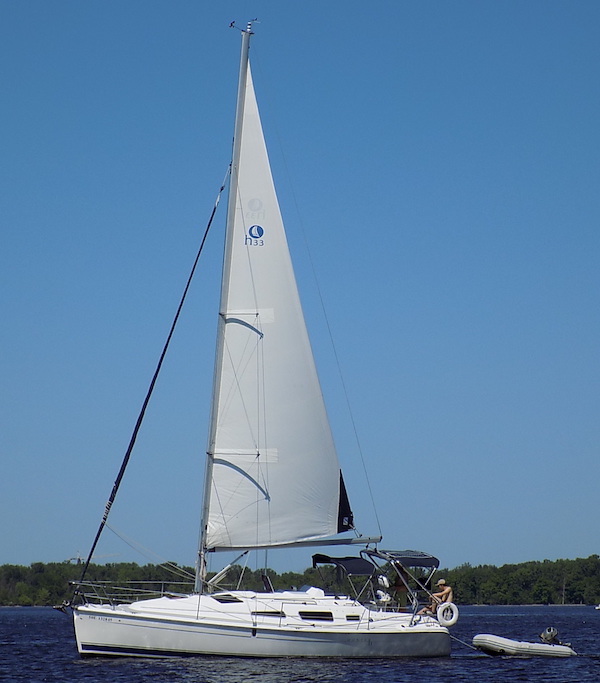
Hunter 33 2 for sale elsewhere on the web:

Main features
| Model | Hunter 33 2 | ||
| Length | 33.50 ft | ||
| Beam | 11.50 ft | ||
| Draft | 4.50 ft | ||
| Country | United states (North America) | ||
| Estimated price | $ 0 | ?? |
Login or register to personnalize this screen.
You will be able to pin external links of your choice.

See how Sailboatlab works in video
| Sail area / displ. | 17.58 | ||
| Ballast / displ. | 32.49 % | ||
| Displ. / length | 193.13 | ||
| Comfort ratio | 21.48 | ||
| Capsize | 2.07 |
| Hull type | Monohull fin keel with bulb and spade rudder | ||
| Construction | Fiberglass | ||
| Waterline length | 29.42 ft | ||
| Maximum draft | 4.50 ft | ||
| Displacement | 11016 lbs | ||
| Ballast | 3579 lbs | ||
| Hull speed | 7.27 knots |

We help you build your own hydraulic steering system - Lecomble & Schmitt
| Rigging | B&R | ||
| Sail area (100%) | 542 sq.ft | ||
| Air draft | 51.92 ft | ||
| Sail area fore | 202.63 sq.ft | ||
| Sail area main | 298.89 sq.ft | ||
| I | 37.42 ft | ||
| J | 10.83 ft | ||
| P | 41 ft | ||
| E | 14.58 ft |
| Nb engines | 1 | ||
| Total power | 21 HP | ||
| Fuel capacity | 25 gals |
Accommodations
| Water capacity | 50 gals | ||
| Headroom | 0 ft | ||
| Nb of cabins | 0 | ||
| Nb of berths | 0 | ||
| Nb heads | 0 |
Builder data
| Builder | Hunter Marine (USA) | ||
| Designer | Glenn Henderson | ||
| First built | 2004 | ||
| Last built | 0 | ?? | |
| Number built | 0 | ?? |
Other photos
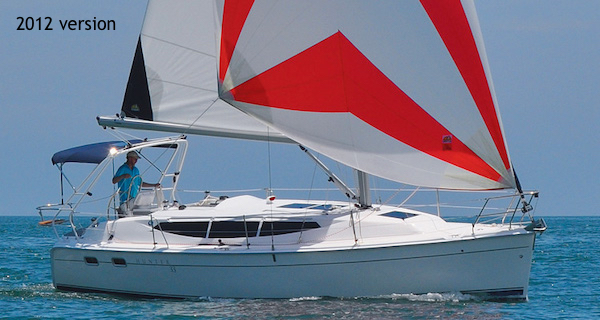
Modal Title
The content of your modal.
Personalize your sailboat data sheet

- Sails & Canvas
- Hull & Structure
- Maintenance
- Sailing Stories
- Sailing Tips
- Boat Reviews
- Book Reviews
- The Dogwatch
Select Page
Hunter 33.5
Posted by Allen Penticoff | Boat Reviews , Monohull , Reviews
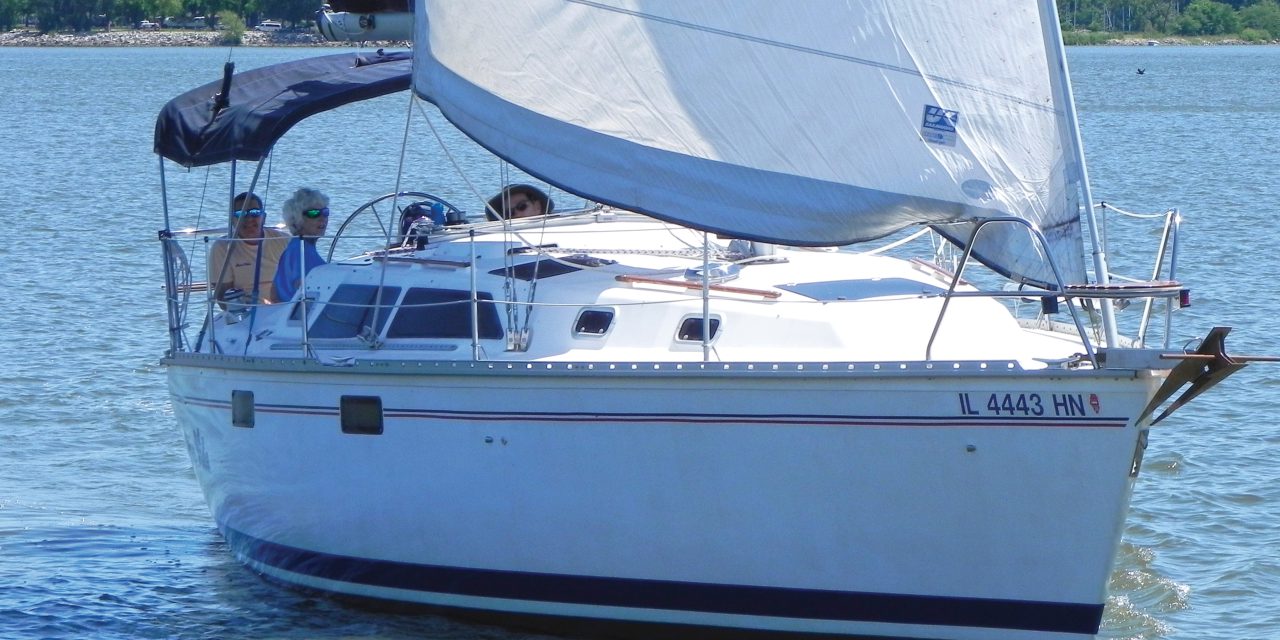
A well-planned economy cruiser
Rich and Carolyn Sutorius of St. Charles, Missouri, sailed a Seafarer 26, Manana , for more than 30 years. We reviewed the boat in the July/August 2019 issue . In 2021, with Rich now retired and Carolyn’s retirement approaching as well, she thought they should move up in boat size when they are able to spend more time aboard at their slip in Boulder Marina on Carlyle Lake in southwestern Illinois.
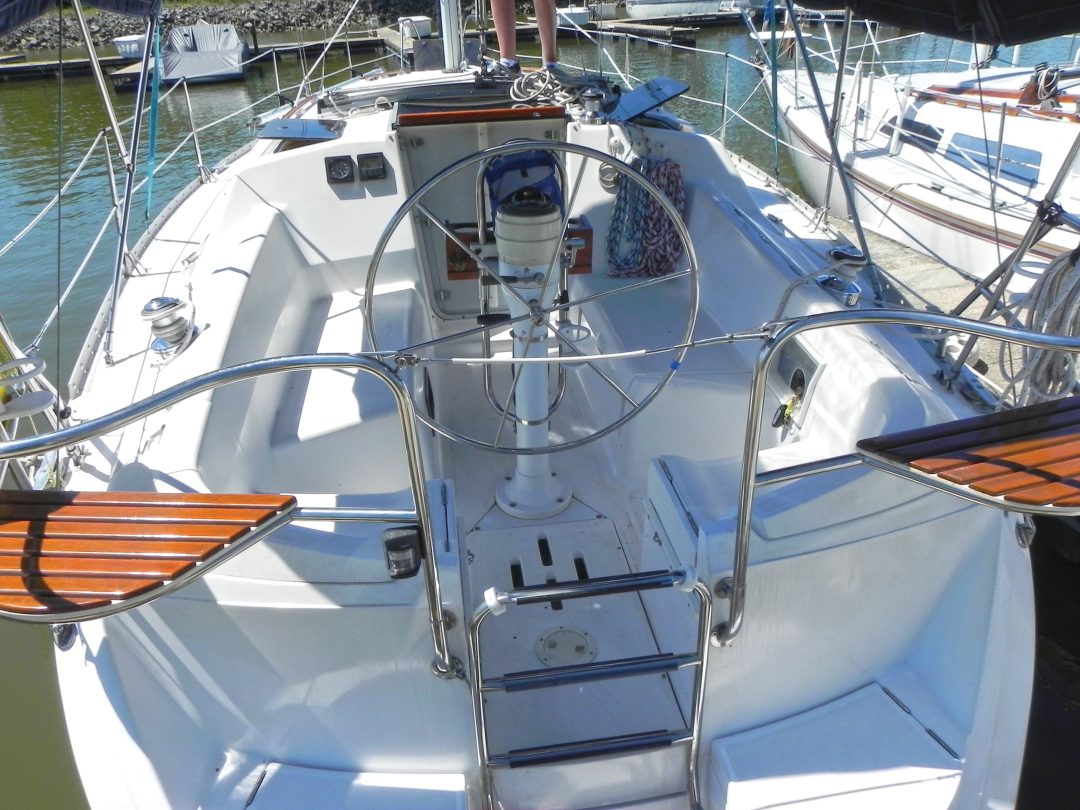
The cockpit is fairly roomy, but it’s a squeeze to get past the wheel, especially with the bimini up.
This request caught Rich by surprise, but he was not about to argue. They searched around the country for a Hunter in the 33-foot range. Most were iffy prospects and somewhat pricey, considering the difficulties in getting it to their landlocked lake. On my advice (we are friends) he asked several Hunter owners at his own marina if they’d like to sell, and as luck would have it, one said yes, even though it wasn’t technically for sale. Rich and Carolyn renamed the boat Pura Vida and launched her the following spring.
The Luhrs family built boats, both power and sail, for decades. Warren Luhrs, son of Luhrs company founder Henry, began the sailboat company in the early 1970s. He became a long-distance ocean racer with boats like Thursday’s Child , incorporating some of his ideas, like B&R rigging, in the production models. With his passing, the brand was bought by Marlow and the boats are marketed as Marlow-Hunters.

The seatback is part of the locker lid and it is somewhat large and clumsy to deal with, as it must be held up with one hand. A gas strut or spring to hold it open would be helpful.
The Hunter 33.5 was built from 1987 to 1994. Some know the 33.5 as the model 335, as there is a follow-on version designed by Rob Mazza called the Hunter 336 that has considerable updating starting in 1995. One can also find a very similar Hunter in the 34. One review, pre-336, says there were some 600 of the 33/33.5s built.
Several keel configurations were supposedly available: fin keel, bulb wing, elliptical wing, and Collins tandem keel. However, it is believed that nearly all of the 33.5s were built with the shoal draft (4 feet 6 inches) bulb wing keel as the review boat has.
Construction
Hunter Marine employed standard materials and construction methods in line with the boats’ intended price points as economy yachts. The hulls were hand-laid E-glass with polyester resin. They were solid, meaning no core material, with a skin coat behind the gelcoat of chopped strand mat sprayed with a chopper gun to help reduce print-through from the fabrics, such as 24-ounce woven roving, that followed. Decks were cored, some with 4-inch squares of plywood, others with sheets of end-grain balsa. Ballast was external.
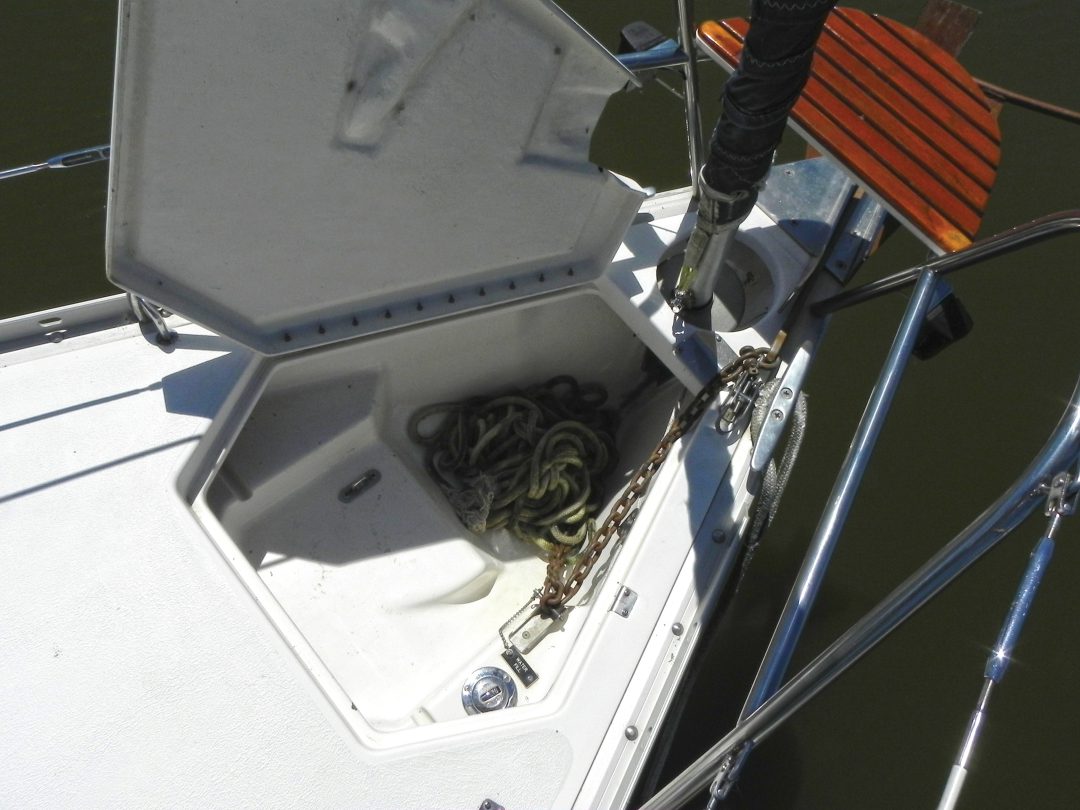
The drum for the headsail furler is recessed in the deck—an interesting detail. Ground tackle is also kept off the deck in a locker.
On my arrival at the marina, Pura Vida was tied stern-to at the dock, which enabled boarding via the transom opening as the humped helm seat had been removed and stowed. Getting around is very easy given the wide, clear sidedecks and the uncluttered cabintop that is ripe for sunbathing and lounging. Adequate handholds are available going forward to handle the anchor from a built-in locker.
The cabin trunk is relatively low, facilitating good forward visibility underway. Aluminum toerails edge the deck, with stainless steel pulpits at both ends and double lifelines between them.
There are two small lockers on the transom swim platform and two in the cockpit in each aft corner, which house the batteries. There is only one big cockpit locker, to starboard, and it’s not all that big or deep.
Engine gauges are to starboard of the wheel, but oddly and inconveniently, the engine cut-off knob is located at the top of the companionway steps. Aft of the wheel is
access to an emergency tiller connection and a large removable panel for service to the steering system. Between the mid-boom traveler just ahead of the companionway and the mast is a flat area clear of hardware that is perfect for lounging and sunbathing, as Carolyn demonstrated.
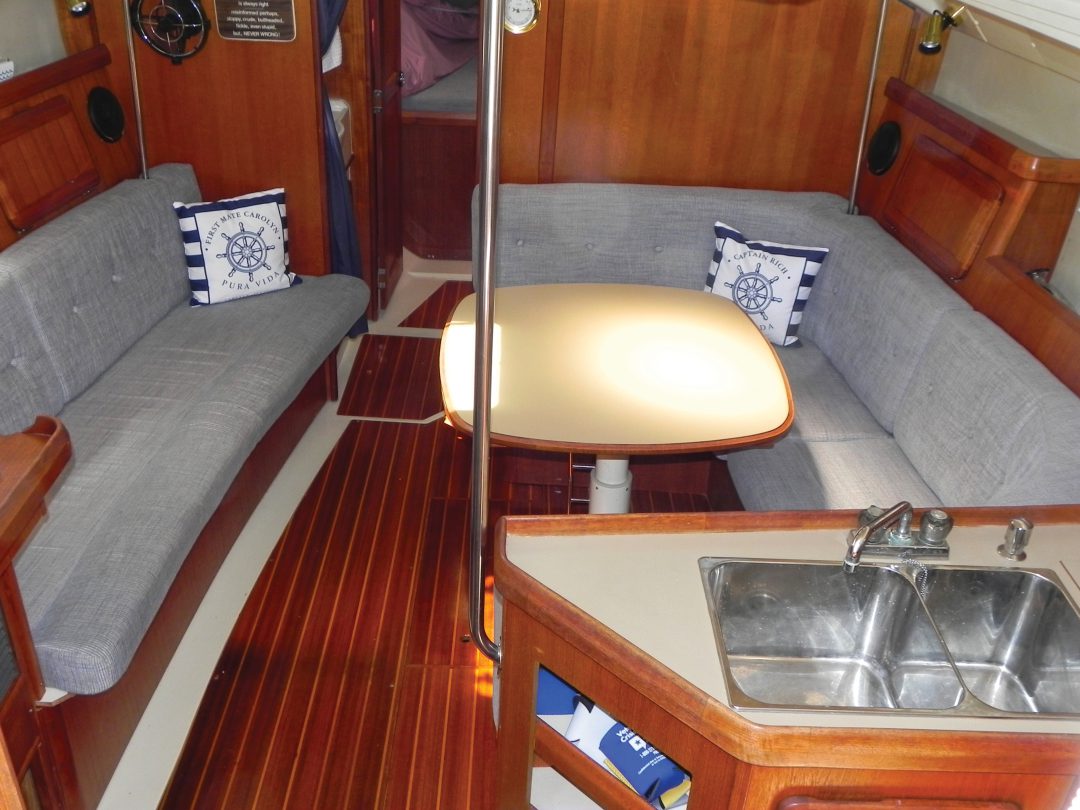
The saloon has a comfy dinette and table that lowers for a berth. Note the stainless steel tube that serves as a deck compression post as well as a much-appreciated handhold.
The rig is a ⁷/₈ fractional sloop, with double swept-back spreaders, double shrouds, and lowers from inboard-mounted chainplates. The backstay splits to free the helm of interference. Although sometimes reported as a B&R rig, it is not a B&R rig. Nonetheless, the swept spreaders do limit how far out the boom can be swung. Pura Vida sports a full-batten mainsail with lazy jacks and a roller-furled 110% headsail. Hunters in general lean toward tall main-driven sail plans with smaller, easier-to-trim jibs, and the 335 is no exception.
Accommodations
Going below, the first impression is a lot of wood and a lot of light. There are plenty of opening hatches that let in light, as well as windows on the cabin trunk sides. The first step is on top of a hinged cabinet/step that has a small handy tool bin under it. This makes a secure place to stand under sail as well. The hatch overhead is a dark acrylic plastic that slides into a sea hood. The way forward unfortunately is not endowed with overhead handholds. A light cream-colored padded vinyl covers non-wood surfaces that lend to the airiness of the cabin.
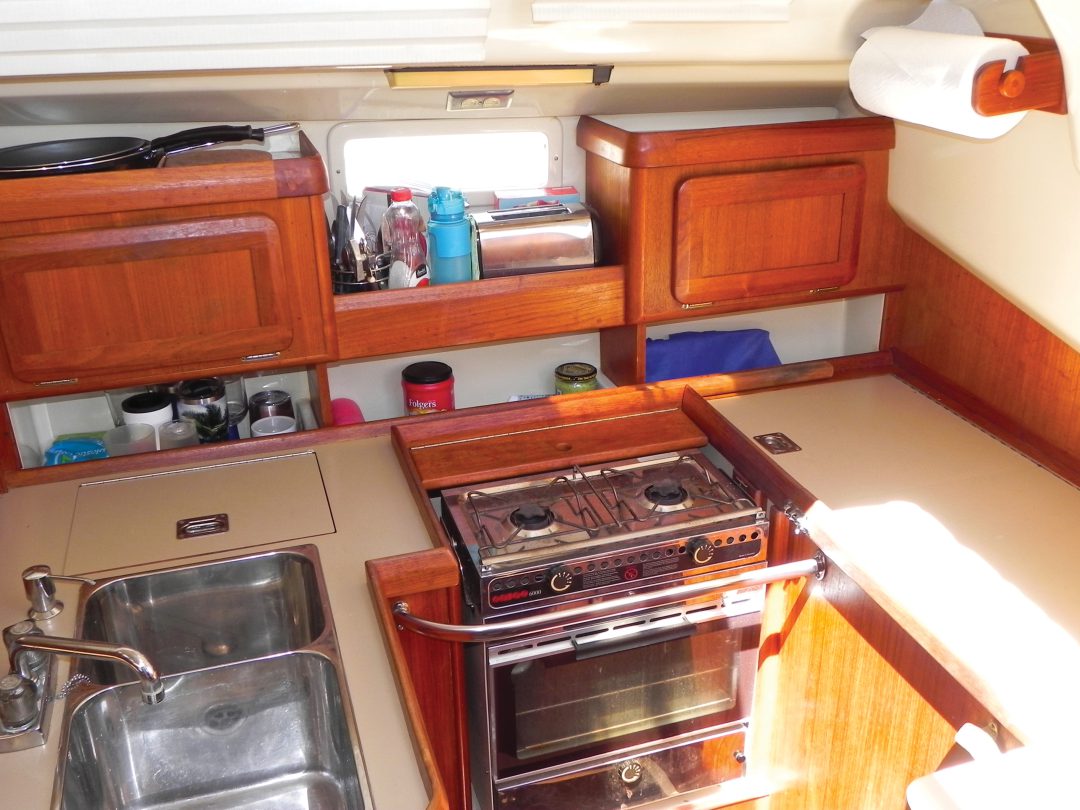
The gimbaled two-burner stove and double sink are nice features, as is the counter space for meal prep.
The forward cabin has a generous V-berth with cabinets and door—no need for an insert. I found it adequate for changing
clothes with the door closed. The aft “guest” cabin has a larger berth, but it suffers from being athwartship under the cockpit and if two are in bed, it makes the aft person in for the night. Couples may wish to split up and take separate cabins. The aft cabin is a great place to recline and read a book. Below the cushions is access to the engine-cooling through-hull, water strainers, fuel filter, prop shaft, and stuffing box. Other cabinets and engine access are found here as well.
The saloon features a wraparound dining table, which lowers to create a berth for two, while the port settee makes a berth once the back cushions are removed. Storage is abundant. The U-shaped galley takes up the aft star- board area, with plenty of workspace. The head/shower is to starboard with a vanity opposite. The head itself has a big lid over it, which Rich fitted with a hook after it fell on a male friend while sailing.
Pura Vida is equipped with a water-cooled marine air conditioner that has ducting to all three cabins.
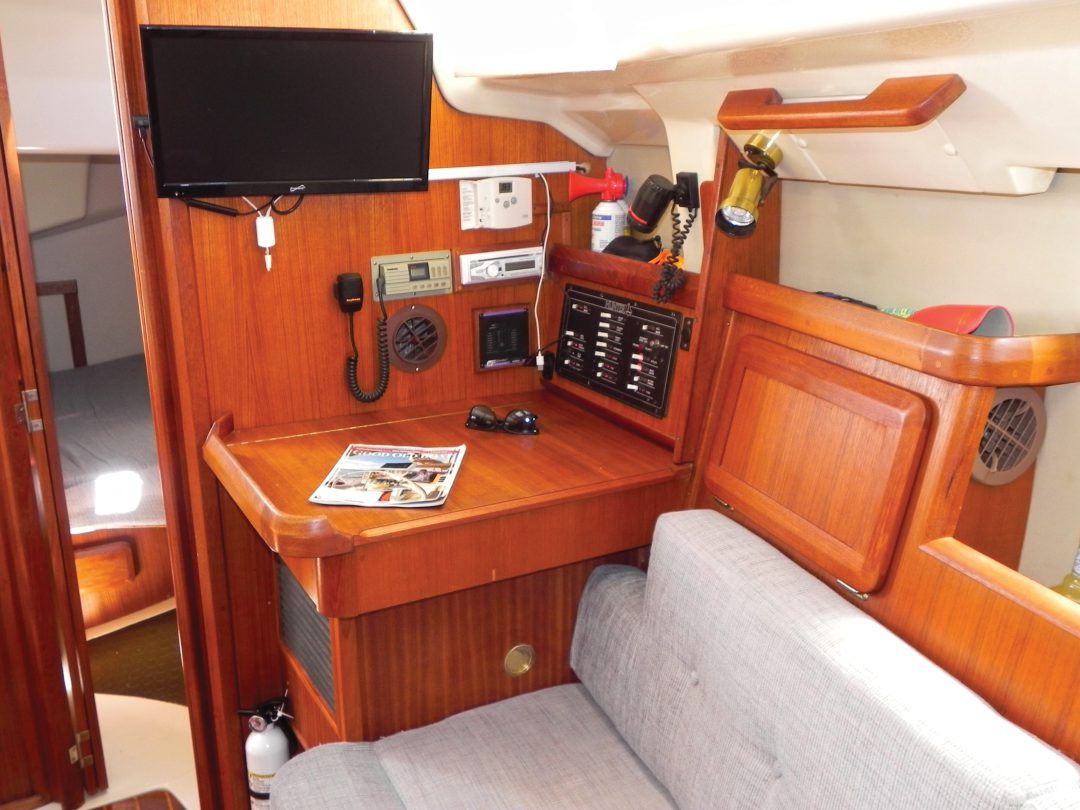
At the aft end of the port settee is the nav station, constructed in wood and with space for instruments and charts. You’ll probably want to stand at it rather than sit sideways.
The Hunter 33.5 handles quite well under sail and under power. With a shoal draft fin/bulb-winged keel and spade rudder, it turns quickly. We managed some tacks to windward quick enough that winching in the sheets was unnecessary. The main is a tad oversized and needs to be reefed early to prevent excessive weather helm. In average conditions there was a hint of weather helm and the helm feel was on the light side, but not quite fingertip control. The split backstays are completely out of the way while you are at the helm and there are many places to sit and steer. My favorite spot on most wheel-steered boats is to recline on the leeward seat snugged up against the coaming and steer with an up-and-down motion on the wheel. Some boats can even be steered with your feet, and this Hunter is one of them. Pura Vida has plush pulpit seats that are comfy for passengers, but they are a bit out of reach for a helmsperson.
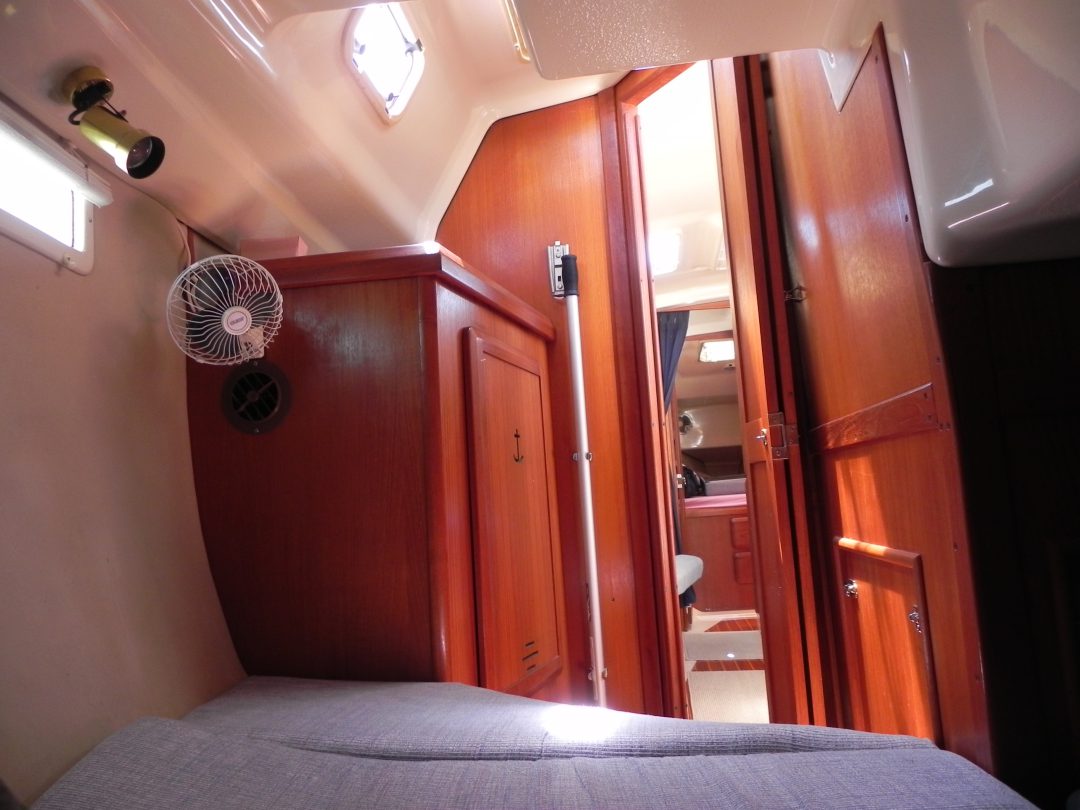
The aft berth, under the cockpit, is wide but not for the claustrophobic.
The cockpit seats are comfy, with adequate width and height. The tops of them are chamfered and blend into the sitting space. However, they are spaced just a bit too far apart to make for comfortable bracing while heeled. As for napability, I give these seats a 3.5 on the Penticoff Napability Index (PNI) of 1-5, with 1 being terrible and 5 being great. The 33.5’s seats are fine for reclining or curling up, but like many smaller yachts with a wheel, the cutout to get around the wheel takes away some of the napping comfort.
Having sailed downwind the length of the lake, we’d been planning to reef for the windward beat back to the marina as whitecaps were running the length of the lake now. However, we decided to take it even easier. We furled the main and then proceeded under jib alone. It was a pleasant sail. Handling was very neutral and light, with tracking spot on. Heel was minimal while pointing to 50 degrees and making 3.5 knots. It was so pleasant that as we came abeam the marina, Carolyn requested we continue for a while longer.
There are no surprises to sailing the Hunter 33.5 downwind or under power— standard stuff. However, Pura Vida’s folding prop has the usual lag when going from forward to reverse.
For PHRF racing, in fleets around the country most 33.5s rate 144–147 seconds per mile.
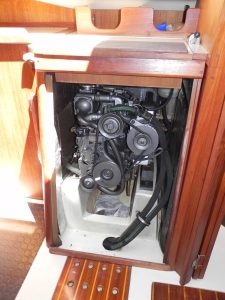
As with most boats, the Yanmar diesel is mounted under the cockpit and behind the companionway ladder. Opinions vary as to its accessibility.
There are many good old boats to choose from in this size range. Many of them are Hunters. Hunters have long been value-oriented production boats rather than top-of- the-line, spare-no-expense boats. Where some find fault with them, others find more boat for less money. I have not sailed a Hunter that I disliked or thought was inadequate for the sort of inshore sailing we usually do.
Listings for the Hunter 33.5 as of July 2022 ranged from $15,000 to $50,000.
There is a very large Hunter owners group online at shop.hunterowners.com for all things mechanical and technical.
Owners’ Comments
Points high and sails well on all points. I thought the hull and rigging were quite good for a relatively low-cost production boat. However, I was very disappointed at the quality of some of the components. The manual bilge pump was the cheapest one they could possibly buy and I had a catastrophic failure the first time I needed to use it. Also, the packing gland housing was made of a plastic material. Apparently, nearly all of the hatches had leaked since the boat was new. Sleeping accommodations were not great. Access to the rear of the engine was difficult.
—John Streatfeild, Guntersville, Alabama
Very small water intake regularly catches weeds and fish and plugs up at the hull. Walk-through and lockers in the swim step on stern are great—but this is still a narrower cockpit that fills up with four people.
—Andy and Sarah Reimer, Nanaimo, British Columbia
This boat is small enough to singlehand and big enough to take on moderate coastal seas. Downwind sailing is better on the B&R rig found on the 335 vs. the Selden rig seen in later models because the spreaders have almost no sweep. There’s a chart table, room for a 16,000 BTU marine A/C, a refrigeration box, and room on the forward bulkhead in the saloon to mount a modern, large flat-screen TV. There is not an option for an anchor roller, nor is there a way to install one on the 1990 335. The plumbing used Qest fittings, which are not readily available today. The standard Yanmar 2GM20F seems to be underpowered.
—Colby Whitfield, Kemah, Texas
Solidly built, set up for singlehanding, and comfortable belowdecks. Especially like the open transom design. I stow my 7.5-foot dink up against the stern. Passageways belowdecks are narrow/tight. Engine access is a bit awkward.
—Jim Mosher, Chesapeake Bay, Maryland
About The Author
Allen Penticoff
Allen Penticoff, a Good Old Boat contributing editor, is a freelance writer, sailor, and longtime aviator. He has trailer-sailed on every Great Lake and on many inland waters and has had keelboat adventures on fresh and salt water. He owns an American 14.5, a MacGregor 26D, and a 1955 Beister 42-foot steel cutter that he stores as a someday project.
Related Posts
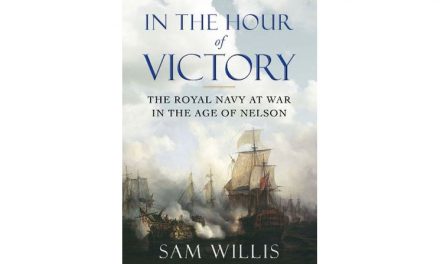
In the Hour of Victory: Book Review
June 1, 2014
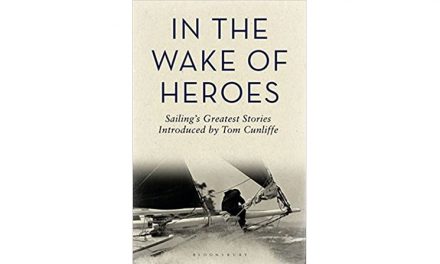
In the Wake of Heroes: Sailing’s Greatest Stories
October 1, 2016
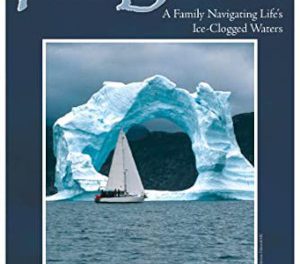
Ice Blink: Book Review
August 1, 2006
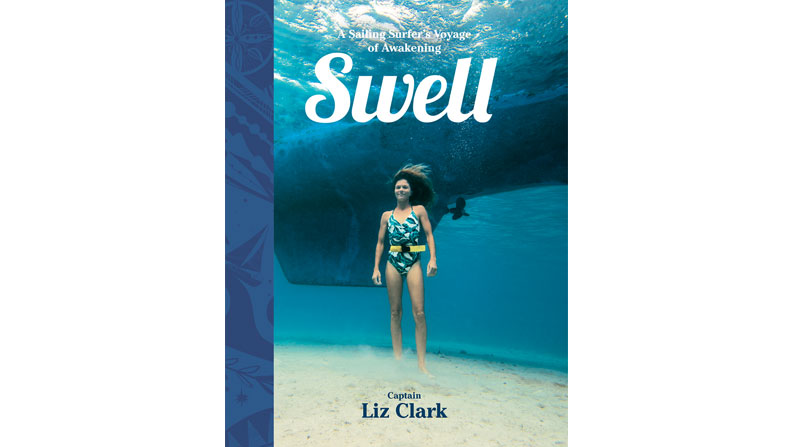
Swell: A Sailing Surfer’s Voyage of Awakening
April 1, 2018
Current Edition
Join Our Mailing List
Get the best sailing news, boat project how-tos and more delivered to your inbox.
You have Successfully Subscribed!

1993 Hunter 33.5 Technical Specs
General data about hunter 33.5.
| Brand | |
| Model | |
| Boat Type | |
| Category | |
| Year Of Production | |
| Condition (New/Used) | |
| Country | |
| Fuel (Gas/Diesel) | |
| Hull Material Used | |
| Length | |
| Selling Price | |
Engine and Power Specs
| Engine manufacturer | |
| Engine Series | |
| Engine Location | |
| Engine Horsepower | |
| Engine Built Year |
Dimensions And Wieght
| LOA (Length Overall) | |
| L.W.L(Length WaterLine) | |
| Displacement (Weight) | |
| Boat Maximum Draft | |
| Boat Keel Type | |
| Beam Width | |
| Ballast System Weight | |
| BC (Bridge Clearance) |
Detailed Specifications
| Waste Water Tank | |
| Numebr of Cabins | |
| Number of Heads (Watercraft) | |
| Gas Tank Size | |
| Drinking Water Tank | |
| Berth (Twin/Double) |
Features And Equipments
Sailing features.
| Genoa |
| Boom vang |
| Battened mainsail |
Safety Features
| Fog bell |
| Flares |
| Emergency tiller |
Other Equipments
| opening ports |
| opening hatches |
| Windex |
| Two hanging lockers-cedar lined |
| Teak handrails |
| Stainless steel bow pulpit |
| Sheet stoppers |
| Self-tailing halyard winch |
| Selected hardwood trim |
| Running lights |
| Mooring cleats |
| Molded vanity with mirror |
| Low-stretch internal halyards |
| Lighted compass |
| Life jackets |
| Jib furling system |
| Icebox |
| Hot and cold pressure water in head |
| Furling genoa |
| Fully enclosed head |
| Full batten mainsail |
| Fire extinguishers |
| Double life lines |
| Convertible dinette table |
| Chart table light |
| Cabin lights |
| Automatic bilge pump |
| Athwartships aft cabin |
| Anodized double spreader fractional rig |
| Anchor roller |
| Anchor light |
| Anchor and line |
| Adjustable mainsheet traveler |
| 27 hp diesel engine, freshwater cooled |
| 20 gal. holding tank |
| 2 speed self-tailing sheet winches |
Interior Specifications
| Water heater |
| Two-burner stove with oven |
| Toilet head |
| Teak and holly cabin sole |
| Shower |
| Oven and cooktop |
| Marine battery charger |
| High pressure laminated countertop |
| Hand bilge pump |
| Freshwater tank |
| Double stainless steel sinks |
| Combination microwave oven |
| Automatic bilge pump |
Exterior Features
| Swim ladder |
| Marine boat table |
| Mainsail cover |
| Bimini top |
Engine And Mechanical Specs
| Hot and cold pressure water system |
Electronical And Electrical Info
| Waterproof marine dvd player |
| Vhf radio with ss antenna |
| Vhf radio |
| Tv & entertainment system |
| Speed log |
| Shore power socket |
| Radio and sterio receiver |
| Navigation center |
| Multiple ac outlets in cabin |
| Marine receiver and cd player |
| Gfi |
| Dual 12 v battery switch |
| Dockside power with cord set |
| Depth sounder instrument |
| Compass steering |
| Autohelm knotmeter, log, depth sounder |
Deck Hardware
| Throwable device |
| Steering wheel (helm) |
| Stainlsee steel stern rail, with teak seats |
| Inboard genoa tracks with cars |
| Five cockpit and transom storage lockers |
| Anodized aluminum through-bolted toe rails |
| Wrap-around coamings |
| T-shaped cockpit |
| Removable contoured helmsman seat |
| Pedistal steering with engine controls |
Hunter 33.5

More 33.5 models
- Hunter provided us with the latest version of its 33.5 service repair manual
- Find All mechanical and electrical parts and accessories of Hunter 33.5 Sail here
Hunter 33.5 competitors

- Residential Customers
- Business Customers
- About Swisscom
- My Swisscom
- Entertainment
- Swisscom blue News & E-Mail
- Swisscom blue TV
- Swisscom blue Cinema
- Swisscom myCloud
Hunting 33-year-old hunter found dead in Graubünden
16.9.2024 - 16:21

A 33-year-old hunter was found dead in Zernez GR on Monday night. He had previously been reported missing by his two colleagues. According to the police, an investigation into the death has been launched.
16.09.2024, 16:21
The 33-year-old left the small hunting lodge in the Alp Munt area at 10.30 p.m. on Sunday evening, the cantonal police of Graubünden wrote on Monday. Because he did not return after some time, his two colleagues alerted the police and began searching for him.
Shortly after 1 a.m., emergency services finally found the dead hunter in the steep terrain. A crash was "very possible", said the Graubünden cantonal police when asked by the Keystone-SDA news agency.
Nevertheless, investigations into the death are currently being conducted in all directions. However, no gunshot wounds have been found. A care team has been called out to look after the relatives.
More from the department

Computer accessories Logitech wants to expand its presence in China

Jörg Kachelmann criticizes "Austrian weather service warned far too late"

Viennese report from the flood zone "Many are shocked"

IMAGES
VIDEO
COMMENTS
LENGTH: Traditionally, LOA (length over all) equaled hull length. Today, many builders use LOA to include rail overhangs, bowsprits, etc. and LOD (length on deck) for hull length. That said, LOA may still mean LOD if the builder is being honest and using accepted industry standards developed by groups like the ABYC (American Boat and Yacht Council).
The Hunter 33 is a popular American sailboat that was designed by John Cherubini and first built in 1977 by Hunter Marine. It has a masthead sloop rig, a fixed fin keel, an inboard motor, and is known for its spacious interior, easy handling and good performance. The boat has undergone several revisions and updates over the years, and has been ...
The Hunter 33 - 2004 is a 33'1" (10.08m) cruising sailboat designed by Hunter Design (United States) and Glenn Henderson (United States). She was built between 2004 and 2012 by Marlow Hunter (United States). The Shoal draft version is offered with a short keel fitted with large winglets. This configuration provides an interesting draft / low center of gravity / upwind performance trade-off.
Hunter 33. Fine performance and vast amenities abound in this versatile, upgraded 33-footer. Boat Review from our November 2012 issue. The boatbuilders at Marlow-Hunter, formerly known as Hunter Marine, may have been too successful, if that's possible, with their prodigious production run of more than 600 Hunter 33 s.
SAIL AREA 501ft2 (furling) 100% FT. FUEL/WATER/WASTE (GAL) 25/50/15. ELECTRICAL 2 x 110AH. ENGINE Yanmar 21hp (saildrive) DESIGNER Glenn Henderson/ Hunter Design Team. BUILDER Hunter Marine, Alachua, FL, 386-462-3077. Photos courtesy of Hunter Marine. The last iteration of the Hunter 33, introduced in 2005, was a big hit for the Alachua ...
The Hunter 33 is a 32.67ft masthead sloop designed by Cherubini and built in fiberglass by Hunter Marine (USA) since 1977. ... The data on this page has been derived from different sources but a significant part is attributed to sailboatdata.com. We thank them for their encouragements and friendly collaboration.
Hunter 33 is a 32′ 8″ / 10 m monohull sailboat designed by John Cherubini and built by Hunter Marine starting in 1977. Great choice! Your favorites are temporarily saved for this session. Sign in to save them permanently, access them on any device, and receive relevant alerts.
The Hunter 33 is a small recreational keelboat, built predominantly of fiberglass, with wood trim.It has a masthead sloop rig, a raked stem, a raised reverse transom, an internally-mounted spade-type rudder controlled by a wheel and a fixed fin keel.It displaces 10,600 lb (4,808 kg) and carries 4,100 lb (1,860 kg) of ballast. [1]The boat has a draft of 5.25 ft (1.60 m) with the standard keel ...
The interior finish adds to the richness with tongue-and-groove flooring and a high-gloss cherry veneer. The grain has been laid out on the bulkheads horizontally, which gives the salon a larger feel. The base price of the Hunter 33 with freight and commissioning is $120,000, and if you add the Mariner package, it goes up to $130,000.
Hunter offers a 4-foot-6-inch shoal-draft version and 5-foot-6-inch deep draft of the new 33. The boat's excitement factor will depend a great deal on the sail plan. Henderson is a firm proponent of the fractional rig, with an easily tacked 110-percent furling jib. To up the fun-factor in light-air, a Code 0 asymmetrical sail will be a good ...
The Hunter 33-2 is a small recreational keelboat, built predominantly of fiberglass. The hull has a solid fiberglass monolithic bottom, with sandwich sides. The deck is a balsa and polyester fiberglass sandwich, with Kevlar reinforcing. [1][2][3][4][5] The design has a fractional sloop B&R rig, a plumb stem, a walk-through reverse transom, an ...
Hunter Marine, Alachua, FL; tel. 800-771-5556. It appears that designer Glenn Henderson is systematically redesigning the entire Hunter line. He's already drawn 21-, 35-, 41-, and 44-footers and now he's turned his computer mouse and designer's eye on the 33-footer. As with Henderson's previous designs, the new Hunter 33 carries its beam well ...
The Hunter 33 2 is a 33.5ft b&r designed by Glenn Henderson and built in fiberglass by Hunter Marine (USA) since 2004. The Hunter 33 2 is a light sailboat which is a reasonably good performer. It is reasonably stable / stiff and has a low righting capability if capsized. It is best suited as a coastal cruiser.
Bulb-wing, fractional rig cruiser. Hunter Marine has combined contemporary styling, performance and very roomy interiors with very low prices to build a successful sailboat line. Their newest is the 33.5. The sailplan shows this to be a handsome design with, by today's standards, moderate freeboard, short ends and a clean wedge-shaped house.
Find Hunter 33 boats for sale in your area & across the world on YachtWorld. Offering the best selection of Hunter boats to choose from.
SA: 625 sq ft / 58.1 sq m. P = 36.42' / 11.10m. E = 13.83' / 4.22m. Optional 29hp engine. An updated version was introduced in 2012 Also referred to as the E33. Same hull and rig. Larger cockpit, deck layout changed plus a swim platform was added. Displacement = 12,400 lbs / 5624 kg. Thanks to Adam Hunt for the photo of the H33-2.
An updated version was introduced in 2012 Also referred to as the E33. Same hull and rig. Larger cockpit, deck layout changed plus a swim platform was added. Displacement = 12,400 lbs / 5624 kg. Thanks to Adam Hunt for the photo of the H33-2. Suggest Improvements. Source: sailboatdata.com / CC BY.
Warren Luhrs, founder of Hunter Marine began in the boat building business, first with his father and brother at Henry Luhrs Sea Skiffs and then Silverton Sea Skiffs. Both companies were quite successful. Being an avid sailor, Luhrs had the idea of applying production line efficiencies to the sailing industry. In 1973, the first Hunter sailboat was launched. This was the HUNTER 25, designed by ...
The Hunter 33.5 was built from 1987 to 1994. Some know the 33.5 as the model 335, as there is a follow-on version designed by Rob Mazza called the Hunter 336 that has considerable updating starting in 1995. One can also find a very similar Hunter in the 34. One review, pre-336, says there were some 600 of the 33/33.5s built.
Hunter 33.5 is a 33′ 4″ / 10.2 m monohull sailboat built by Hunter Marine between 1987 and 1994. Great choice! Your favorites are temporarily saved for this session.
Comfort ratio = D ÷ (.65 x (.7 LWL + .3 LOA) x Beam^1.33), where displacement is expressed in pounds, and length is expressed in feet. Capsize Screening Formula (CSF): Designed to determine if a boat has blue water capability.
Hunter 33.5 Manual: Engine and Power Specs. Engine manufacturer: Yanmar : Engine Series: 3GM30F : Engine Location: Inboard : Engine Horsepower: 20.13 kw / (27.00 hp) Parts And Accessories: Hunter 33.5 Parts : Engine Built Year: 1993 : Dimensions And Wieght. LOA (Length Overall) 10.16 Meters / (33 feet and 4 inch)
A 33-year-old hunter was found dead in Zernez GR on Monday night. He had previously been reported missing by his two colleagues. The police have opened an investigation into the death.